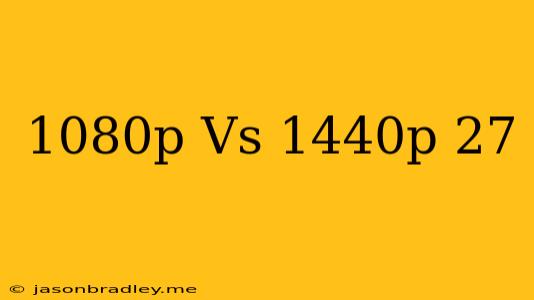1080p vs 1440p: Which Resolution is Right for You?
Choosing the right monitor resolution can be a daunting task, especially with the influx of options available. Two popular contenders are 1080p (1920x1080) and 1440p (2560x1440), both offering different advantages and disadvantages.
This article will delve into the key differences between these two resolutions, particularly focusing on 27-inch monitors, to help you make an informed decision for your specific needs.
1080p: The Budget-Friendly Choice
1080p is the most common resolution found in monitors and TVs, thanks to its widespread adoption and affordability.
Pros:
- Lower price point: 1080p monitors are generally cheaper than 1440p monitors, making them a more budget-friendly option.
- Wider availability: 1080p monitors are widely available, making it easier to find the perfect one for your needs.
- Higher refresh rates and response times: Due to lower pixel density, 1080p monitors can achieve higher refresh rates and faster response times, crucial for gamers and competitive players.
Cons:
- Lower pixel density: On a 27-inch monitor, 1080p can appear slightly pixelated, especially when viewing content up close.
- Less detail and clarity: Compared to 1440p, 1080p offers less detail and sharpness, particularly noticeable in images and text.
1440p: Sharper and More Immersive
1440p, also known as QHD, offers a significant increase in pixel count compared to 1080p. This translates to a crisper and more detailed viewing experience.
Pros:
- Higher pixel density: 1440p offers a higher pixel density, resulting in sharper images and text on a 27-inch monitor.
- Increased detail and clarity: The extra pixels provide a noticeable improvement in detail and clarity, enhancing the overall visual experience.
- More immersive experience: The increased resolution creates a more immersive viewing experience, especially for multimedia content and gaming.
Cons:
- Higher price: 1440p monitors are typically more expensive than 1080p monitors.
- Lower refresh rates and response times: 1440p monitors generally have lower refresh rates and response times compared to 1080p monitors.
Conclusion: The Right Resolution for You
The choice between 1080p and 1440p boils down to your individual priorities and budget:
- Budget-conscious gamers: 1080p provides the best value for money, offering high refresh rates and response times at a lower price.
- Multimedia enthusiasts: 1440p offers a sharper and more detailed viewing experience, ideal for enjoying movies, photos, and web browsing.
- Professional users: 1440p is a preferred choice for professional users who require high-quality visuals for design, video editing, and other demanding tasks.
Ultimately, the best resolution for you depends on your individual needs and preferences. Consider your budget, the type of content you consume, and the tasks you perform to make the right decision.
